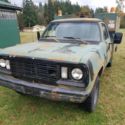1951 Dodge M-37 Military Truck
| Make: | Dodge |
| Model: | M-37 |
| Type: | -- |
| Year: | 1951 |
| VIN: | 800087710 |
| Color: | Green |
| Engine: | -- |
| Fuel: | Gasoline |
| Transmission: | -- |
| Drive type: | -- |
| Interior color: | -- |
| Vehicle Title: | -- |
| Item location: | Staunton, Illinois, United States |
1951 Dodge M-37 Additional Info:
Available now is this amazing 1951 Dodge M-37 American Military Truck. This Dodge is finished in the original military livery both inside and out and has been well preserved. This was part of a military museum and now available for private ownership. The Dodge is powered by the 3.8L inline 6 cylinder engine mated to a manual transmission.The 1951 Dodge M-37 is a military vehicle that was produced by the Dodge division of Chrysler Corporation for the United States Army during the Korean War era. It was designed to be a versatile workhorse, capable of handling a wide range of tasks in various terrain conditions.
The M-37 was powered by a 78 horsepower, 230 cubic inch (3.8 liter) inline six-cylinder engine that produced 180 lb-ft of torque. It was mated to a four-speed manual transmission and featured four-wheel drive with locking front and rear differentials, making it highly capable off-road.
The body of the M-37 was designed to accommodate various types of cargo and personnel, and could be configured in a number of different ways. It was available as a cargo truck, ambulance, personnel carrier, and other variants. The cargo bed could be fitted with troop seats or racks for carrying equipment, and the truck was also equipped with a winch for pulling heavy loads.
The M-37 saw extensive use during the Korean War, as well as in other conflicts and peacekeeping missions around the world. Its rugged design and impressive off-road capabilities made it a popular choice for military organizations around the world.
Today, the 1951 Dodge M-37 is a popular collectible vehicle among military history enthusiasts and collectors. Its unique design, impressive capabilities, and association with one of the most significant conflicts of the 20th century make it a fascinating piece of military history and a testament to the durability and versatility of American engineering.











